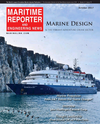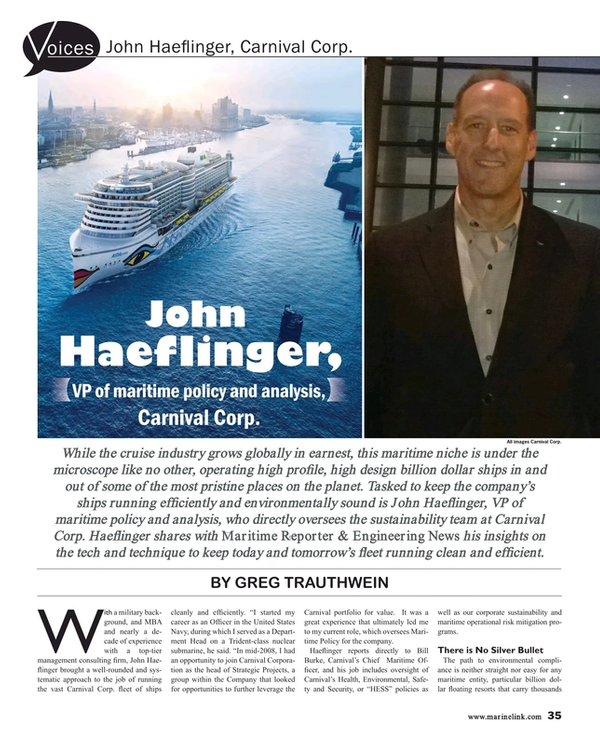
Voices: John Haeflinger, Carnival Corp.
By Greg Trauthwein
Voices: John Haeflinger, VP of maritime policy and analysis, Carnival Corporation
While the cruise industry grows globally in earnest, this maritime niche is under the microscope like no other, operating high profile, high design billion dollar ships in and out of some of the most pristine places on the planet. Tasked to keep the company’s ships running efficiently and environmentally sound is John Haeflinger, VP of maritime policy and analysis, who directly oversees the sustainability team at Carnival Corp. Haeflinger shares with Maritime Reporter & Engineering News his insights on the tech and technique to keep today and tomorrow’s fleet running clean and efficient.
With a military background, and MBA and nearly a decade of experience with a top-tier management consulting firm, John Haeflinger brought a well-rounded and systematic approach to the job of running the vast Carnival Corp. fleet of ships cleanly and efficiently. “I started my career as an Officer in the United States Navy, during which I served as a Department Head on a Trident-class nuclear submarine, he said. “In mid-2008, I had an opportunity to join Carnival Corporation as the head of Strategic Projects, a group within the Company that looked for opportunities to further leverage the Carnival portfolio for value. It was a great experience that ultimately led me to my current role, which oversees Maritime Policy for the company.
Haeflinger reports directly to Bill Burke, Carnival’s Chief Maritime Officer, and his job includes oversight of Carnival’s Health, Environmental, Safety and Security, or “HESS” policies as well as our corporate sustainability and maritime operational risk mitigation programs.
There is No Silver Bullet
The path to environmental compliance is neither straight nor easy for any maritime entity, particular billion dollar floating resorts that carry thousands of passengers globally. However in the past five years, Haeflinger concedes that “our leading investment in and development of Exhaust Gas Cleaning Systems (EGCS) has been the ‘lead story,’ systems that will continue to deliver air emission improvements well into the next “Global ECA” decade.”
With environmental standards growing increasingly tighter, he concedes that there is no silver bullet solution, instead a mixed bag of technology and technique that must be jointly developed and deployed to meet and exceed environmental goals.
“Looking 2-10 years ahead, we have clearly committed to emissions reductions through our decision to invest billions of dollars in LNG powered ships (7 of them currently on order),” said Haeflinger. “These ships will run on LNG while alongside and at sea – resulting in a reduced GHG footprint relative to conventional ships.” To illustrate Carnival’s commitment, Haeflinger puts the investment in perspective: “By 2020, we will have invested well over $1 billion in environmental upgrades to our ships, including the energy efficiency and EGCS investments.”
The Never Ending Challenge
Keeping any fleet in compliance with global, regional and local environmental regulations is no small fleet, particularly challenging for cruise ships, floating cities with thousands of passengers.
“I don’t think many people outside of those who live it every day realize the breadth, depth and complexity of the environmental regulatory framework placed on the shipping industry, and it’s not getting any simpler,” said Haeflinger. “One of the biggest near-term challenges for us is the upcoming waste water quality standards for the Baltic Sea. The standards are extremely difficult to achieve using available on board equipment and the Baltic ports are not all capable of receiving ashore the waste water volumes we will need to offload.” Wastewater is just one challenge, and when considering the breadth of environmental investment it is important to first realize that cruise ships are 30+ year assets, with many of the ships in the fleet are operating on older technology. Simultaneously the company must investigate and invest in technologies for the existing fleet while “at the same time we seek radical improvements in the efficiencies of our new ships.” Despite the company’s considerable investment in LNG, the biggest short to medium term challenge is GHG reduction. “Renewable sources of energy are simply not yet available to us in a way that will allow us to radically reduce our GHG footprint over night,” said Haeflinger. “Our investments to reduce hull friction, improve air conditioning system efficiencies, recapture and reuse waste heat, install LED lighting, and even the recent inking of our long-term performance-based maintenance agreement with Wärtsilä which is designed to further improve our main engine efficiency, illustrate the focus we have had and continue to have on making our fleet more energy efficient and reducing our GHG rate, which is our lead 2020 sustainability goal.”
“Over the next 10-15 years, it is clear that we as an industry will need to find a carbon neutral fuel – it is unclear exactly what that will be, but we have a number of initiatives in place to evaluate potential options.”
The Power of Partnership
Even a corporation with Carnival’s heft is best served by not ‘going it alone,’ counting on key partnerships to help develop and deliver new technologies onboard. “Choosing partners carefully is clearly important, and we recognize that a good partner who shares goals, vision (and shares in the investment) is worth far more than one who doesn’t and is only in for themselves in the short term,” said Haeflinger. “Our recently announced partnerships with Shell (for LNG supply) and Wärtsilä (for engine maintenance and energy efficiency) illustrate our interest in and commitment to establishing mutually beneficial partnerships in this space. Equally if not more important has been our relationship with Ecospray, who has been an absolutely instrumental partner in the development of our EGCS program.”
Perhaps the biggest challenge for Haeflinger and his team are designing tomorrow’s fleet, ships that must entertain and return investment for 30 years or more, all the while meeting ever stricter environmental rules. Haeflinger believes that size and scale will remain important trends, though he does concede the smaller, specialty vessel trend can be profitable in certain segments. And while he and the Carnival team are eager to engage new technologies, they are selective. “From a technical perspective, after scale comes efficiency not only in terms of energy use, but also in terms of environmental impact. However, “low emission” ships are clearly not a silver bullet concept, and “gadget” solutions like small scale solar panels will not move the needle,” he said. “Future designs will need to incorporate a broad suite of technologies to further reduce the environmental footprint of ships and will need to address all airborne and waterborne emissions, not just those currently regulated.”
With all of the investment in making ships more environmentally benign, simultaneously addressing other areas of technology on the ship could be lost. But not on Carnival.
“I also see further (and likely a step-change) integration and use of new technologies, including remote key system performance monitoring software, intelligent condition-based maintenance programs, and automated decision aids/tools for the crew to drive further efficiencies and lower impacts. I also see developments in the area of better integrating the human element into new ship designs. Optimized bridge and engine control room designs will be supported by training, in our case, through our global, state-of-the-art training facility in Almere, outside of Amsterdam, in the Netherlands.”
The LNG Push
With the laying of AIDAnova’s keel in Germany on September 6, 2017, Carnival Corporation marked the official start of construction for a total of seven cruise ships that will be fully powered by liquefied natural gas (LNG). Meyer Werft lowered the first building block into place for AIDAnova, the first cruise ship worldwide that can be operated both at sea and in port with LNG. In the presence of AIDA President Felix Eichhorn, Bernard Meyer, CEO of Meyer Werft, and Tim Meyer, CEO of Meyer Werft, two trainees named Louisa Tröbner (AIDA Cruises) and Martin de Boer (Meyer Werft) placed the traditional lucky coin under the first of a total of 90 blocks.
Arnold Donald, president and CEO of Carnival Corporation, together with Bernard Meyer, CEO Meyer Werft, Michael Thamm, CEO Costa Group and Carnival Asia, David Dingle, Chairman Carnival UK (P&O Cruises UK), Neil Palomba, President of Costa Cruises, and Felix Eichhorn, President of AIDA Cruises, - gave the official "full steam ahead" signal, ringing in a new era of the commercial use of low-emission LNG in cruise travel. The seven LNG ships for cruise brands Carnival Cruise Lines, Costa Cruises, Carnival UK, and AIDA Cruises will be built by Meyer Werft in Papenburg (Germany) and Turku (Finland) and commissioned between 2018 and 2022.
(As published in the October 2017 edition of Maritime Reporter & Engineering News)
Read Voices: John Haeflinger, Carnival Corp. in Pdf, Flash or Html5 edition of October 2017 Maritime Reporter
Other stories from October 2017 issue
Content
- Supporting Silent Ships page: 14
- Cyber Shoal Waters page: 18
- US Shipbuilding: The Road Ahead page: 22
- Keller Shifts Gears page: 24
- MAN Introduces the 'Game Changer' page: 26
- Voices: Bjarne Foldager, MAN Diesel & Turbo page: 30
- Voices: John Haeflinger, Carnival Corp. page: 35
- Designer-built Adventure Cruise page: 40
- Robert Allan Ltd. Designs for the American Market page: 46
- Foreship: A Guiding Design Light amid a Quagmire of Regulations page: 50
- Hans Beele's Mission to Build Sealing Valley page: 58
- Ship of the Month: October 2017 page: 62


